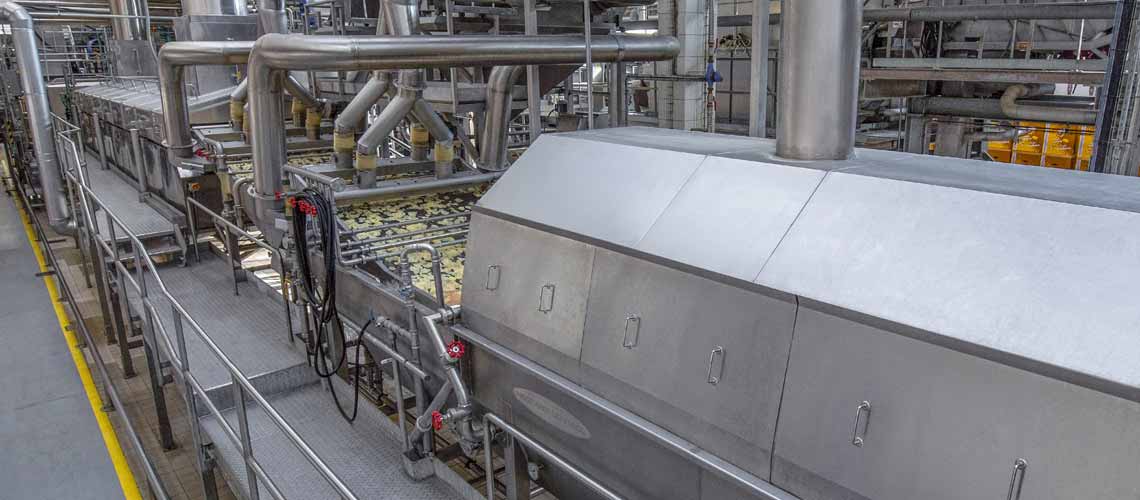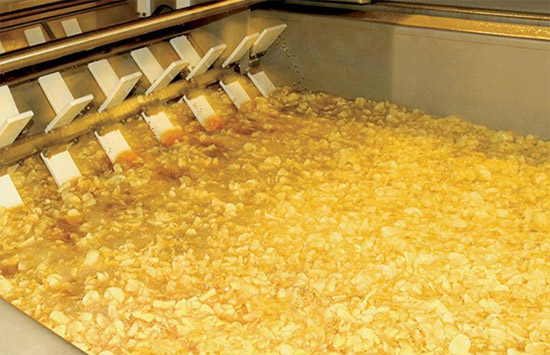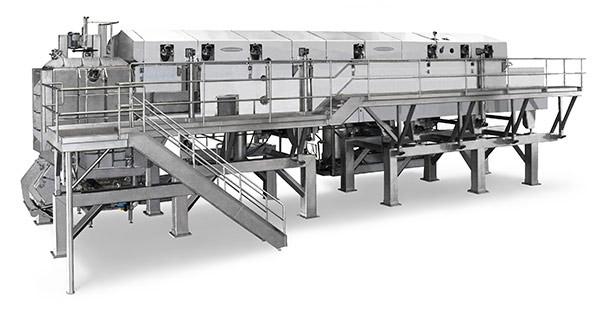The steps involved in frying a sliced raw potato

Potato chips are consistently a top seller in the highly competitive snack food market. To maintain popularity, manufacturers have developed a wide variety of flavors and styles. The manufacturing process, however, is fairly similar between them and manufacturers generally seek common objectives: a finished product with no defects, crumbs, or blisters and with a good appearance and a bright color.
Making potato chips begins with the raw potato and ends with the final packaged product. This article covers the middle process, frying the washed, peeled, and sliced product before it goes to inspection and packaging.
 Frying time and temperature will vary depending on variety of potato, specific gravity, slice thickness, and possible sugar content reduction. These two parameters of frying are not constant and must be adjusted to produce uniform quality chips. Generally, a higher temperature translates to a shorter frying time and less oil absorption. An excessively high temperature will result in burnt or caramelized chips and quicker oil breakdown.
Frying time and temperature will vary depending on variety of potato, specific gravity, slice thickness, and possible sugar content reduction. These two parameters of frying are not constant and must be adjusted to produce uniform quality chips. Generally, a higher temperature translates to a shorter frying time and less oil absorption. An excessively high temperature will result in burnt or caramelized chips and quicker oil breakdown.
The steam released from the potatoes forms a blanket of non-oxidizing gas over the oil. This furnishes the steam blanket as well as provides a continuous deodorization of the oil. A positive effect is that undesirable products do not accumulate because of a rapid turnover of oil, a result of constant replenishment with fresh oil to compensate for what is absorbed by the chips. A negative effect of water vaporization is that antioxidants, such as butylated hydroxytoluene (BHT), are steam distilled out of the oil. BHT delays rancidity and flavor deterioration in the potato chips.
Specially designed equipment can be provided to increase the temperature of the chips after they emerge from the fryer and provide a significant reduction in oil content. As steam is being rapidly released from the slices, oil absorption will be low. As the protective layer of water vapor begins to disperse in the final stages of frying, fat enters the voids left in the dehydrated cells.
Hydrolysis
This occurs when chemical bonds holding triglycerides together are broken by water, creating free acids. Frying systems with high oil turnover rates usually maintain acceptable oil quality and the steam realized tends to strip free fatty acids (FFA) from the oil.
Oxidation
The primary reaction is the formation of hydro peroxides. Higher numbers of double bonds in the unsaturated oil will increase the rate of oxidation. This reaction is enhanced by heavy ions. Copper is a potent oxidation catalyst, and its use must be avoided. No copper fittings or brazings should be used in frying equipment.
Polymerization
The two major types that occur are:
The oil used for frying has two functions:
Some of the factors affecting the amount of oil absorbed by the potato slice are:
FFA increase during frying, due to a reaction between the oil and the water released by frying. FFA will rise and should be maintained below 0.5%. This reaction causes the oxygen to react with the double bonds in the unsaturated FFA. Their values above 0.5% will detrimentally affect the quality and shelf life of the processed food. Initially peroxides are formed, which in turn breakdown to ketones and aldehydes. The peroxide value may be helpful in measuring the degree of oxidative rancidity in the oil.
The smoke point is the temperature indicated when the oil gives off a thin, continuous stream of bluish smoke. The smoke point of the oil is an excellent
indicator of fresh oil quality. Good oils (as received) will have a smoke point of well over 482°F (250°C). As the oil is used the smoke point will be proportionally reduced.
Technology enables a higher level
 Potato chip manufacturers can increase their processing capabilities substantially with vacuum fryer technology. Heat and Control's Unitized Vacuum Fryer (UVF) is a self-contained vacuum fryer that saves space and controls acrylamide.
Potato chip manufacturers can increase their processing capabilities substantially with vacuum fryer technology. Heat and Control's Unitized Vacuum Fryer (UVF) is a self-contained vacuum fryer that saves space and controls acrylamide.
The complete system was designed and manufactured by Heat and Control to process 500 kg 1,100 lbs (500 kg) per hour of finished potato chips and features their support/auxiliary equipment including Vacuum Generation System, KleenSweep®, Centrifugal Oil Filtration System, Heat Exchanger, Fryer Support Module, PLC System Controls, Automatic Heated Centrifuge, and Fryer Support Platform.
The patented UVF is unique because it does not have an external vacuum chamber. The unitized design eliminates an external vacuum chamber: the fryer is its own vacuum chamber, similar to a ship-in-a-bottle. This makes it significantly easier to maintain and to clean, requires less floor space, and allows the vacuum fryer to act like a regular non-vacuum fryer. This design innovation validates Heat and Control’s snack processing expertise and commitment to the industry.
The UVF technology offers product line extension for snack manufacturers. High sugar food products that traditional frying system were unable to turn into snacks can now be processed into unique snack products. The UVF will fry products with high sugar content, such as apples, carrots, sweet potatoes, high sugar potatoes, beets without over-browning. In addition, the UVF can minimize formation of acrylamide by frying at lower temperature.